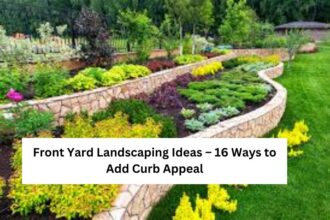Introduction:
Landscaping your outdoor space can be a fulfilling endeavor, offering a chance to express creativity while enhancing the beauty and functionality of your property. While professional landscapers have their trade secrets, there are tips and techniques they might not readily share. Here are four secret tips for DIY landscaping designs that will elevate your outdoor space without breaking the bank.
Understanding Your Space:
Before diving into any landscaping project, take the time to thoroughly understand your outdoor space. Assess the size, shape, and existing features such as trees, slopes, and drainage patterns. Consider the climate and soil conditions unique to your area, as they will dictate the types of plants that thrive and the landscaping techniques that work best.
Budgeting Wisely:
Effective budgeting is essential for any DIY landscaping project. Start by setting a realistic budget that considers not only the cost of materials but also any additional expenses such as tools or professional assistance if needed. Look for ways to save money without compromising quality, such as opting for locally sourced materials or repurposing existing elements in your landscape.
Choosing the Right Plants:
Selecting the right plants is crucial for a successful landscaping design. Research plants that are well-suited to your climate and soil type, as they will require less maintenance and be more likely to thrive. Consider incorporating native plants, which are adapted to the local environment and support local wildlife. Choose a variety of plants with different colors, textures, and heights to create visual interest and balance in your landscape.
Designing with Depth and Dimension:
To create a visually appealing landscape, focus on designing with depth and dimension. Incorporate elements such as pathways, retaining walls, and focal points to add layers and visual interest to your outdoor space. Utilize a variety of textures, colors, and shapes to create contrast and focal points that draw the eye and create a sense of depth.
DIY Hardscaping Techniques:
Hardscaping elements such as pathways, patios, and retaining walls can add structure and functionality to your landscape. While these projects may seem daunting, there are many DIY techniques that can help you achieve professional-looking results. Invest in quality materials and take the time to plan and prepare properly before starting any hardscaping project.
Sustainable Landscaping Practices:
Incorporating sustainable practices into your landscaping design not only benefits the environment but can also save you time and money in the long run. Consider implementing techniques such as xeriscaping, which focuses on using drought-tolerant plants and minimizing water usage. Explore options for eco-friendly materials and practices, such as using recycled materials or installing a rainwater harvesting system.
Maintaining Your Landscape:
Regular maintenance is essential for keeping your landscape looking its best year-round. Develop a maintenance schedule that includes tasks such as watering, fertilizing, pruning, and weeding. Be proactive in addressing any issues that arise, such as pests, diseases, or drainage problems, to prevent them from escalating into larger problems.
Troubleshooting Common Issues:
Even the most well-planned landscapes can encounter issues such as pests, diseases, or drainage problems. Familiarize yourself with common landscaping issues and how to address them effectively. Consider environmentally friendly solutions whenever possible, such as companion planting to deter pests or incorporating rain gardens to manage excess water.
Enhancing Curb Appeal:
Boosting curb appeal not only enhances the beauty of your home but can also increase its value. Pay attention to the entrance of your property, adding welcoming touches such as a well-maintained pathway, colorful flowers, and outdoor lighting. Incorporate focal features such as a water feature or sculpture to create visual interest and draw attention to key areas of your landscape.
Personalizing Your Space:
Make your outdoor space truly your own by incorporating personal touches and unique elements. Add DIY décor and art pieces that reflect your personality and style, such as handmade garden sculptures or custom-built furniture. Consider creating themed areas or outdoor rooms that cater to different activities or moods, such as a cozy reading nook or a vibrant entertaining space.
Safety Considerations:
Safety should always be a priority when undertaking any landscaping project. Familiarize yourself with the proper use of tools and equipment, and always follow manufacturer guidelines and safety precautions. Take precautions to protect yourself from sun exposure, dehydration, and other outdoor hazards, and enlist the help of friends or family for larger projects that require heavy lifting or specialized skills.
Seeking Inspiration:
Don’t be afraid to seek inspiration from others when planning your landscaping design. Explore online resources such as gardening blogs, social media platforms, and landscaping forums for ideas and advice. Visit botanical gardens, nurseries, and public parks to gather inspiration and see different landscaping styles and techniques in action.
DIY vs. Hiring Professionals:
While DIY landscaping can be rewarding, there are times when it may be beneficial to enlist the help of a professional landscaper. Consider factors such as the size and complexity of your project, your level of expertise and available time, and your budget when deciding whether to tackle a project yourself or hire a professional. In some cases, investing in professional assistance can save you time, effort, and frustration in the long run.
Conclusion:
Embarking on a DIY landscaping project can be a fulfilling and rewarding experience, allowing you to create a beautiful outdoor space that reflects your personality and style. By following these secret tips and techniques, you can achieve professional-looking results while saving money and adding value to your property. Remember to plan carefully, budget wisely, and enjoy the process of transforming your outdoor space into a haven of beauty and tranquility.
FAQs:
- Can I tackle a DIY landscaping project if I have little to no experience?
- Absolutely! Many DIY landscaping projects can be completed with basic skills and tools. Start with smaller projects and gradually build your confidence and expertise.
- How do I know which plants are suitable for my climate?
- Research local plant species or consult with experts at your local nursery or gardening center. They can recommend plants that are well-adapted to your climate and soil conditions.
- What are some cost-effective materials for landscaping projects?
- Consider using recycled materials, such as reclaimed wood or salvaged bricks, for hardscaping projects. You can also save money by purchasing plants from local growers or propagating them yourself from seeds or cuttings.
- How often should I water my landscape?
- The frequency of watering will depend on factors such as rainfall, soil type, and plant species. Monitor the moisture levels in your soil and adjust your watering schedule accordingly to prevent over or under-watering.
- When should I consider hiring a professional landscaper?
- If you’re tackling a large or complex project, or if you lack the time or expertise to do it yourself, hiring a professional landscaper may be a wise investment. They can offer expert advice, save you time and effort, and ensure professional-quality results.





